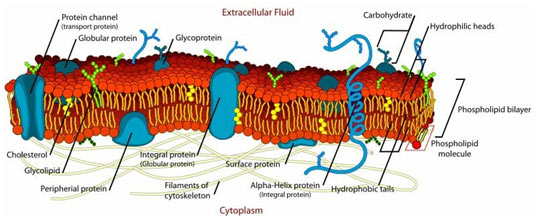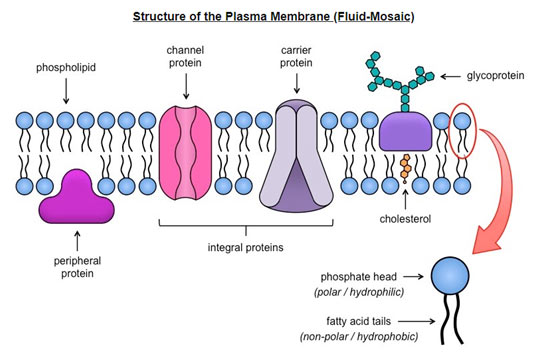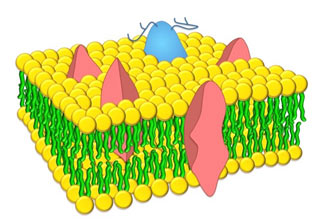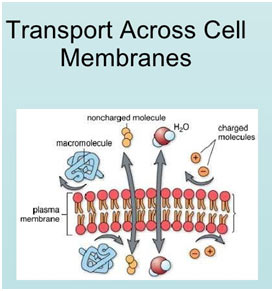In this article, we will discuss the chemical composition, structure, and functions of the plasma membrane but firstly we have to know about the plasma membrane.
- 1) What is the plasma membrane?
- 2) Chemical Structure of Plasma Membrane
- 3) Models of the structure of Plasma Membrane
- 4) Modern Concept
- 5) Functions of Cell Membrane
- 6) Multiple-Choice Questions (MCQs) with Answers:
- 7) Frequently Asked Questions (FAQs) – Plasma Membrane: Structure, Composition, and Functions
- 8) Wrapping up Plasma Membrane
What is the plasma membrane?
Plasma membrane or cell membrane is the external most layer of the cell. However, in a lot of plant cells, it is covered by a cell wall. The cell membrane is chemically composed of lipids and proteins; 60 – 80% are proteins, while 20-40% are lipids. In addition, there is a small quantity of carbohydrates.

Chemical Structure of Plasma Membrane
The membrane is primarily composed of lipids, proteins, and carbohydrates. Water makes up about 29% of the total weight. Robertson (1959) proposed that the plasma membrane is a three-layered structure where proteins form the external and inner layers of the membrane that confines lipids to form a unit membrane.
1.Lipid
The lipids identified in the plasma membrane include cholesterol, phospholipids, and galactolipids.
Phospholipids
The phospholipids include phosphatidylcholine, phosphatidylethanolamine, and sphingomyelin. The phospholipids are discovered to be related to the external protein shell in the plasma membrane. Glycerol and fatty acid make up lipid molecules.
In the membrane, the lipid molecules consist of two parts– a head and two tails. The head is composed of glycerol and is hydrophilic whereas the tails are composed of fatty acids that are hydrophobic. The head and tail are normally designated as polar and nonpolar end respectively. The proteins, in the membrane, exist in 2 layers and the lipids are present in between them.
The lipid particles are oriented in 2 (bimolecular) layers with their hydrophilic polar ends directed towards protein and the hydrophobic nonpolar ends face each other. Hydrogen bonds, ionic linkages or electrostatic forces bind the protein and lipid parts.
2.Carbohydrates
They are present in the form of glycolipids and glycoproteins. Both of these types are confined solely to the external membrane surface area. Bell (1962) is of the viewpoint that polysaccharides provide some stability to the lipoprotein complex in the membrane.
3.Protein
In the membrane, it exists as enzyme protein, carrier protein, and structural protein. The enzyme proteins have catalytic activity. The carrier proteins assist in transporting materials in and out of the cell throughout the membrane. The structural proteins play a crucial function in forming the structure of the membrane.
Models of the structure of Plasma Membrane
Various designs were put forward about the physiochemical nature of the plasma membrane.
Old Concepts
1.Charles Overton
He found that the substances which dissolved in lipids get in more rapidly than substances insoluble in lipid. Therefore, he concluded that the plasma membrane was made up of lipid.
2.I. Langmuir
He made artificial membranes by including phospholipids in Benzene to water. Benzene vaporized and phospholipids membrane was formed.
E.Gorter and F. Grendel
They explained that cell membranes are phospholipid bilayers. The hydrophobic ends of the phospholipid molecules are directed inward and hydrophilic ends of the membrane are directed outward. Gorter and Grendel also attempt to measure the precise contents of the plasma membrane. But they failed.
Modern Concept
Fluid Mosaic Model
- Jonathan Singer and Garth Nicholson established the fluid mosaic model of membrane structure in 1972. Cell membranes are represented according to a fluid-mosaic model, due to the fact that they are:
Fluid— the phospholipid bilayer is viscous and individual phospholipids can move position.
Mosaic— the phospholipid bilayer is embedded with proteins, leading to a mosaic of components.
The plasma membrane that surrounds these cells has 2 layers (a bilayer) of phospholipids (fats with phosphorous connected), which at body temperature resemble vegetable oil (fluid). And the structure of the plasma membrane supports the old stating, “Oil and water don’t mix.”
Each phospholipid particle has a head that is attracted to water (hydrophilic: hydro = water; philic = loving) and a tail that repels water (hydrophobic: hydro = water; phobic = fearing). Both layers of the plasma membrane have the hydrophilic heads pointing towards the exterior; the hydrophobic tails form within the bilayer.

Because cells reside in a watery environment (extracellular fluid), and they include a watery solution inside of them (cytoplasm), the plasma membrane forms a circle around each cell so that the water-loving heads touch with the fluid and the water-fearing tails are secured on the inside.
Proteins and compounds such as cholesterol become embedded in the bilayer, offering the membrane the appearance of a mosaic. Because the plasma membrane has the consistency of vegetable oil at body temperature, the proteins and other compounds have the ability to move across it. That’s why the plasma membrane is described using the fluid-mosaic model.
The molecules that are embedded in the plasma membrane likewise serve a function. For example, the cholesterol that is stuck in there makes the membrane more stable and prevents it from solidifying when your body temperature is low. (It keeps you from actually freezing when you’re “freezing.”) Carbohydrate chains attach to the outer surface area of the plasma membrane on each cell. These carbohydrates specify to every person, and they supply qualities such as your blood type.

Functions of Cell Membrane
Transport of products is one of the crucial roles it provides to the cell. It offers a barrier between the cell contents and their environment, allowing just selective substances to pass through it, thus it is called a differentially permeable or selectively permeable membrane.
The substances which are lipid-soluble cross it more quickly than others, therefore, it manages the flow of materials and ions to preserve a definite gradient. Many little gas molecules, water, glucose, etc. being neutral can quickly cross while ions, being charged particles, have some difficulty in crossing.
Many substances that are not required, continuously get into the cell by passive transportation, others are taken up against the concentration gradient (they move from the area of low concentration to the area of high concentration). This uphill movement of materials needs energy and is described as active transport. The energy used for this motion is provided by ATP.

In numerous animal cells, the cell membrane assists in taking in products by infolding in the form of vacuoles. This type of consumption is described as endocytosis which can be either phagocytosis (to engulf solid particles) or pinocytosis (to take in the liquid product).
In nerve cells (afferent neuron) the cell membrane transfers nerve impulses from one part of the body to the other to keep coordination.
Multiple-Choice Questions (MCQs) with Answers:
- What is the primary component of the plasma membrane?
- a) Proteins
- b) Carbohydrates
- c) Lipids
- d) Water
- Answer: c) Lipids
- What is the percentage composition of proteins in the cell membrane?
- a) 20-40%
- b) 40-60%
- c) 60-80%
- d) 80-100%
- Answer: c) 60-80%
- Which lipid is found in the plasma membrane?
- a) Triglycerides
- b) Phospholipids
- c) Steroids
- d) Waxes
- Answer: b) Phospholipids
- What is the function of glycolipids and glycoproteins in the plasma membrane?
- a) Catalysis
- b) Structural support
- c) Transport
- d) Cell recognition
- Answer: d) Cell recognition
- Who proposed the Fluid Mosaic Model of the plasma membrane?
- a) Charles Overton
- b) I. Langmuir
- c) Gorter and Grendel
- d) Jonathan Singer and Garth Nicholson
- Answer: d) Jonathan Singer and Garth Nicholson
- What does the Fluid-Mosaic Model represent?
- a) Rigid structure
- b) Dynamic and flexible structure
- c) Two-dimensional structure
- d) Non-mosaic structure
- Answer: b) Dynamic and flexible structure
- What makes the plasma membrane viscous according to the Fluid Mosaic Model?
- a) Proteins
- b) Lipids
- c) Carbohydrates
- d) Cholesterol
- Answer: b) Lipids
- Which component of the plasma membrane prevents it from solidifying at low temperatures?
- a) Proteins
- b) Carbohydrates
- c) Cholesterol
- d) Phospholipids
- Answer: c) Cholesterol
- What is the primary role of the plasma membrane in transport?
- a) Endocytosis
- b) Exocytosis
- c) Active transport
- d) Selective permeability
- Answer: d) Selective permeability
- What type of transport requires energy to move substances against the concentration gradient?
- a) Passive transport
- b) Facilitated diffusion
- c) Active transport
- d) Osmosis
- Answer: c) Active transport
- Which process involves the engulfing of solid particles by the cell membrane?
- a) Pinocytosis
- b) Endocytosis
- c) Exocytosis
- d) Phagocytosis
- Answer: d) Phagocytosis
- What function does the plasma membrane serve in nerve cells?
- a) Cell recognition
- b) Structural support
- c) Transfers nerve impulses
- d) Endocytosis
- Answer: c) Transfers nerve impulses
- What provides the energy for active transport in the plasma membrane?
- a) Glucose
- b) ATP
- c) Oxygen
- d) Water
- Answer: b) ATP
- Which of the following lipids is a component of the plasma membrane?
- a) Triglycerides
- b) Phospholipids
- c) Steroids
- d) Waxes
- Answer: b) Phospholipids
- What is the role of glycoproteins in the plasma membrane?
- a) Catalysis
- b) Structural support
- c) Cell recognition
- d) Active transport
- Answer: c) Cell recognition
- Who proposed the Fluid Mosaic Model of the plasma membrane?
- a) Charles Overton
- b) I. Langmuir
- c) Gorter and Grendel
- d) Jonathan Singer and Garth Nicholson
- Answer: d) Jonathan Singer and Garth Nicholson
- What does the Fluid-Mosaic Model represent?
- a) Rigid structure
- b) Dynamic and flexible structure
- c) Two-dimensional structure
- d) Non-mosaic structure
- Answer: b) Dynamic and flexible structure
- What makes the plasma membrane viscous according to the Fluid Mosaic Model?
- a) Proteins
- b) Lipids
- c) Carbohydrates
- d) Cholesterol
- Answer: b) Lipids
- Which component of the plasma membrane prevents it from solidifying at low temperatures?
- a) Proteins
- b) Carbohydrates
- c) Cholesterol
- d) Phospholipids
- Answer: c) Cholesterol
- What is the primary role of the plasma membrane in transport?
- a) Endocytosis
- b) Exocytosis
- c) Active transport
- d) Selective permeability
- Answer: d) Selective permeability
- What type of transport requires energy to move substances against the concentration gradient?
- a) Passive transport
- b) Facilitated diffusion
- c) Active transport
- d) Osmosis
- Answer: c) Active transport
- Which process involves the engulfing of solid particles by the cell membrane?
- a) Pinocytosis
- b) Endocytosis
- c) Exocytosis
- d) Phagocytosis
- Answer: d) Phagocytosis
- What function does the plasma membrane serve in nerve cells?
- a) Cell recognition
- b) Structural support
- c) Transfers nerve impulses
- d) Endocytosis
- Answer: c) Transfers nerve impulses
Frequently Asked Questions (FAQs) – Plasma Membrane: Structure, Composition, and Functions
- What is the plasma membrane?
- Answer: The plasma membrane, also known as the cell membrane, is the outermost layer of the cell. It is composed of lipids and proteins, with 60-80% being proteins and 20-40% lipids, and in some plant cells, it is covered by a cell wall.
- What is the chemical composition of the plasma membrane?
- Answer: The plasma membrane is primarily composed of lipids, proteins, and a small quantity of carbohydrates. Lipids include cholesterol, phospholipids, and galactolipids, while proteins exist as enzyme proteins, carrier proteins, and structural proteins.
- How are lipids structured in the plasma membrane?
- Answer: Lipids in the plasma membrane, such as phospholipids, have a head (hydrophilic) and two tails (hydrophobic). These lipids form a bilayer with hydrophilic heads directed outward towards proteins and hydrophobic tails facing each other.
- What role do carbohydrates play in the plasma membrane?
- Answer: Carbohydrates are present in the form of glycolipids and glycoproteins on the external membrane surface. They are involved in cell recognition and provide stability to the lipoprotein complex in the membrane.
- Who proposed the Fluid Mosaic Model of the plasma membrane?
- Answer: The Fluid Mosaic Model was proposed by Jonathan Singer and Garth Nicholson in 1972.
- How is the Fluid Mosaic Model described?
- Answer: According to the Fluid Mosaic Model, the plasma membrane is fluid, as the phospholipid bilayer is viscous and allows individual phospholipids to move. It is also mosaic, embedded with proteins, creating a mosaic of components.
- What prevents the plasma membrane from solidifying at low temperatures?
- Answer: Cholesterol, embedded in the plasma membrane, makes it more stable and prevents solidification at low temperatures.
- What is the primary function of the plasma membrane?
- Answer: The plasma membrane acts as a selectively permeable barrier, controlling the flow of substances between the cell and its environment. It maintains a definite gradient and facilitates transport of materials through passive and active processes.
- How does the plasma membrane assist in the transport of materials?
- Answer: The plasma membrane enables transport through processes like passive diffusion for lipid-soluble substances and active transport for uphill movement of materials, requiring energy from ATP. Endocytosis, such as phagocytosis and pinocytosis, is also involved.
- What role does the plasma membrane play in nerve cells?
- Answer: In nerve cells, the plasma membrane transfers nerve impulses, facilitating communication and coordination between different parts of the body.
Wrapping up Plasma Membrane
The plasma membrane, also known as the cell membrane, serves as the outermost layer of a cell, defining its boundary. Composed primarily of lipids (20-40%), proteins (60-80%), and a small quantity of carbohydrates, the plasma membrane plays a crucial role in maintaining cellular integrity and facilitating various functions.
Chemical Composition:
- Lipids: Cholesterol, phospholipids (phosphatidylcholine, phosphatidylethanolamine, sphingomyelin), and galactolipids.
- Proteins: Enzyme proteins, carrier proteins, and structural proteins.
- Carbohydrates: Present as glycolipids and glycoproteins on the external membrane surface.
Models of Structure:
- Old Concepts:
- Charles Overton: Proposed that the plasma membrane is lipid-based.
- I. Langmuir: Created artificial membranes using phospholipids.
- E. Gorter and F. Grendel: Described the cell membrane as phospholipid bilayers.
- Modern Concept – Fluid Mosaic Model:
- Developed by Jonathan Singer and Garth Nicholson in 1972.
- Describes the plasma membrane as fluid (phospholipid bilayer allowing movement) and mosaic (embedded with proteins).
- Two layers of phospholipids form a bilayer, resembling vegetable oil in structure.
Functions of the Cell Membrane:
- Transport: Acts as a selectively permeable membrane, regulating the passage of substances between the cell and its environment.
- Maintaining Gradient: Manages the flow of materials and ions to maintain a definite gradient.
- Active Transport: Involves uphill movement of materials against the concentration gradient, requiring energy from ATP.
- Endocytosis: Facilitates the intake of materials through processes like phagocytosis and pinocytosis.
- Nerve Impulse Transmission: In nerve cells, the membrane transfers nerve impulses for coordination.
In summary, the plasma membrane’s dynamic structure, comprising lipids, proteins, and carbohydrates, is essential for the cell’s integrity, communication, and regulation of material transport. The Fluid Mosaic Model provides a contemporary understanding of its physiochemical nature, emphasizing its fluidity and mosaic composition.
